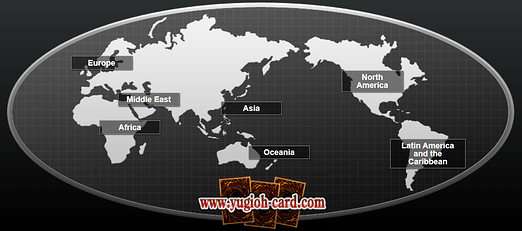This is my first Yu-Gi-Oh article I’ve written, so give me a break. ![]()
If you’re reading this and you’ve played the Yu-Gi-Oh card game for awhile, then you have probably encountered the terms: TCG (Trading Card Game) and OCG (Official Card Game). Most players follow the rulings and mechanics that pertain to their local region. Hence, it may not be of interest for those players to learn how players play the game in another part of the world - or is it?
The division of TCG and OCG has existed since 2002 when the game was brought to North America, but the topic of discussing their differences has been a subject of taboo for some reason. Apart from the obvious differences in banlists and cards, there are other subtle differences that are not that easy to find.
So why is this suddenly important now? With the covid-19 pandemic, more players have sought online simulators, both official and unofficial to play. In both cases, the automatic simulators follow the OCG rulings. Hence, it’s important for players to know what exactly is different so that they do not mistakenly follow the wrong ruling corresponding to their region. The purpose of this article, thus, is to pinpoint those differences and the reasons for them.
Demographics
Before we start though, let us take a look at the distribution of the different regions in the world that play Yu-Gi-Oh. In this world map, which is the first thing one sees on the official Yu-Gi-Oh website, Asia is the only region that corresponds to OCG. All other regions play the TCG. The distribution is quite unequal in terms of number of regions wouldn’t you say? However, if we were to compare the populations of these regions, Asia, still eclipses all the other regions combined.

Of course, these demographics don’t accurately reflect the number of Yu-Gi-Oh players for each region, but are just the overall population at a glance. Furthermore, India and China, the two largest populations in Asia, are actually not even included in the regions listed under Asia by the OCG. That is, if we were to only count the countries in Asia that correspond to OCG, it would include Hong Kong, Japan, Thailand, Singapore, South Korea, Taiwan, Philippines, and Malaysia. Just recently, on April 16, 2020, Konami authorized Shanghai Windo Entertainment Co. to officially distribute the card game in China.1
In each region, the cards are printed in different languages. Cards that are released in the OCG but not the TCG, are not allowed in sanctioned TCG events and vice versa. There is truly only one time during the year where TCG and OCG players can interact - The World Championships. During this time, the TCG and OCG banlists are combined and only cards released in all regions can be allowed. It’s interesting to note that based on history, whenever there is a conflict between TCG and OCG rulings during the World Championships, the OCG rulings have always been used.2
Since 2008, the game has gone through cycles of ruling changes deemed “master rules” that occur approximately every three years. In each new iteration of master rules, the OCG introduces new mechanics which the TCG eventually adopts. Let’s discuss the major differences that exist in terms of rules and mechanics between TCG and OCG today.
Difference #1
The first major difference between the TCG and OCG is the SEGOC (Simultaneous Effects Go On Chain), which is just one part of the Chain Rules.3 That is, SEGOC is the component that explains what happens when multiple card effects activate at the same time. For example, a Player Tributes a “Sangan” for a “Zaborg the Thunder Monarch”. Both cards have mandatory trigger effects and are activated simultaneously. With Master Rules 3, in the TCG, Sangan would always be Chain Link 1 and Zaborg would be Chain Link 2. The reasoning behind this was that Sangan was sent to the GY first before Zaborg was placed on the field. Hence, while they are activated simultaneously, their activation conditions are not simultaneous. In contrast, in the OCG, the timing of the activation conditions was not considered and the player could choose the order of the chain allowing one to be able to activate Zaborg before Sangan.
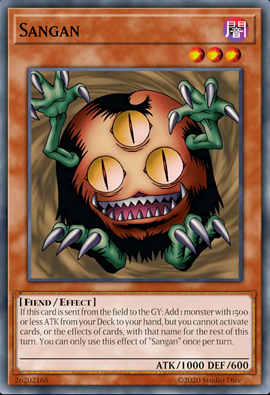
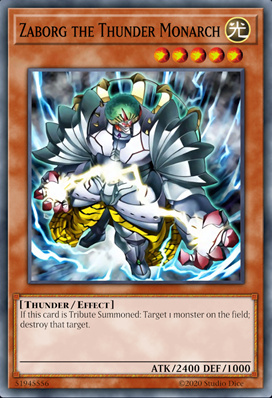
However, note that in the TCG, one could also choose the chain order of simultaneous effects if the activation conditions were also met at the same time. An example is if Sangan and Peten the Dark Clown were destroyed by Dark Hole. In this case, both Sangan and Peten the Dark Clown went to the Graveyard simultaneously, so even in the TCG, the Player could choose the chain order between Sangan and Peten the Dark Clown.
With the advent of Master Rules 4 (the fourth iteration of master rule changes) introduced in July 21st, 2017, the TCG changed its rules so that the Player could choose the order of simultaneous trigger effects ignoring when those activation conditions were met. This means in the previous example, one could activate Zaborg before Sangan if they choose to even in the TCG.
However, there still exists a difference today in how the SEGOC works in the TCG as opposed to OCG. To understand this difference, we need to talk about priority. You can read about it in the official TCG English rulebook.4
To put it simply, priority works like this:
- Turn Player’s mandatory trigger effects
- Opponent’s mandatory trigger effects
- Turn Player’s optional trigger effects
- Opponent’s optional trigger effects
Ok but you already knew this. So what’s different in OCG?
What’s different in the OCG is the priority level of non-public cards. We’ve known about this since 2017, but this term is not found in the official TCG or OCG rulebook. The only documentation on priority level can be found in the “perfect rulebook”. What’s that you may ask? It’s a book Shueisha published in Japanese only. You have to buy it to get it. It has basic and advanced rules for the Yu-Gi-Oh! card game that you already know, but it also includes more detail on rules that are not printed in either the TCG or OCG rulebooks.5
According to the perfect rule book, priority level hierarchy is as follows:
- Priority Level High - Mandatory Trigger Effects
- Priority Level Medium - Optional Trigger Effects
- Priority Level Low - Non-public Trigger Effects6
Here, the non-public cards refer to cards that are known only to 1 player such as face-down cards and cards in the hand. These are the lowest priority level followed by optional triggered effects and mandatory trigger effects that are face-up and public knowledge. This extra priority level of non-public cards adds a new layer of complexity. If multiple cards of the same priority level would be activated, they form a chain in the order prefered by the player.
To understand this, let’s take an example. Player 1 Normal Summons “Goblindberg” and uses its effect to Special Summon another Level 4 monster in their hand. Player 1 also has a “Kagetokage” in their hand so its effect is also triggered after “Goblindberg” is Summoned. Player 2 has a face-down “Torrential Tribute” on the field who has also met its activation conditions after “Goblindberg” was Summoned.
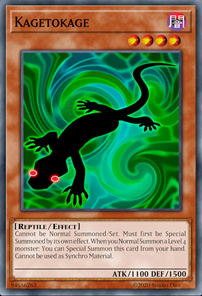
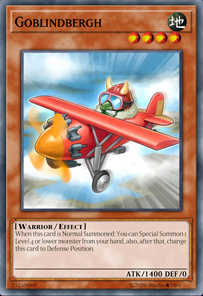

Now, based on what was discussed, should the Turn Player be able to choose the order of activation between Goblindberg and Kagetokage? In the TCG, they can because they are on the same priority level.
In the OCG, the “Kagetokage” is treated as a lower priority level since it’s non-public (in hand). Therefore, the Turn Player can never choose “Kagetokage” as Chain Link 1. The priority also passes from the Turn Player to the Opponent after “Goblindberg” activates its optional trigger effect. This allows the Opponent to chain “Torrential Tribute” as Chain Link 2. Then, “Kagetokage” would be Chain Link 3.
Both “Torrential Tribute” and “Kagetokage” are non-public cards, and are treated as lower priority.
This is very important to understand since if “Torrential Tribute” was Chain Link 3, it would have destroyed the Goblindberg, but not Kagetokage. The example discussed above is straight from the official konami database.7,8 Ok, but what if we replace Torrential Tribute with another non-public card, a hand trap?
Let’s take another example.
Player 1 Normal Summons “Brohunder” while they have a “Kagetokage” in their hand. Brohunder’s effect is used to add a Level 4 LIGHT Thunder-Type monster from the Deck to the hand. Kagetokage’s effect is also triggered to Special Summon itself from the hand. Both are optional trigger effects. Player 2 has an “Ash Blossom” in their hand which can be activated in response to Brohunder’s search effect.


So what would be the possible order of activation now?
After Brohunder is Normal Summoned, turn priority is passed to the opponent. This is because the Kagetokage is a non-public trigger effect. Now, Player 2 has the priority to activate their optional fast effects. Therefore, Player 2 may chain “Ash Blossom” in response before “Kagetokage” is triggered because Ash Blossom is a Quick Effect. Even though Ash Blossom is also a non-public card, it is a Quick Effect not a Trigger Effect, so it has priority before the Kagetokage.
Even though “Ash Blossom” and “Kagetokage” are both non-public and the same priority level, the Opponent may still activate “Ash Blossom” before the “Kagetokage” because the turn priority passes after “Goblindberg”’s effect activates. Imagine if Kagetokage could be chained to Brohunder, then it would be Chain Link 2 and Ash Blossom would have missed its timing to activate in response to Brohunder.
This small difference in order could change the outcome of a duel.
The current TCG Rulebook is an accurate translation of the current OCG Rulebook which was reprinted following MR4. However, the Perfect Rulebook, an addendum to the OCG Ruelbook was never translated and never came to the TCG. Since this ruling on non-public priority was omitted from the official OCG Rulebook, it never reached the TCG Rulebook.
Difference #2 (no longer a difference)
The next one is no longer a difference since April 1st, 2020 with the advent of Master Rules 5 (the fifth iteration of master rules). However, I think it’s still interesting to discuss it nonetheless so let’s shall!
Let’s say Player 1 has a Set Call of the Haunted, and a Satellarknight Deneb in the Graveyard. Player 2 activates Mystical Space Typhoon (mst), targeting Player 1’s Call of the Haunted. Player 1 then chains Call of the Haunted as Chain Link 2, targeting Satellarknight Deneb. The chain resolves backwards. Call of the Haunted Special Summons Satellarknight Deneb, and then Mystical Space Typhoon destroys Call of the Haunted. This immediately destroys Satellarknight Deneb in the process. Note that Sattelarknight Deneb’s effect has not yet activated. Now a new chain begins, where the effect of Satellarknight Deneb can activate due to its “if” wording as opposed to another monster like Red Gadget that would miss its timing. However, Deneb is no longer on the field - can it still activate its effect?



Before Master Rules 5, you could activate the effect of Deneb in the OCG and also in the EU-TCG (Europe).9 However, in the US-TCG, if a card moves away from its activation location before its effect is activated, then its effect cannot be activated. This ruling was already being used in NA-TCG (North America), but following Master Rules 5, the OCG has also adopted this rule. Hence, in the previous example, Deneb can no longer activate its effect even in the OCG.10,11
This is a pretty significant change and good since it brings TCG and OCG one step closer towards unity. Note that this isn’t the same thing as missing timing. Here, a card effect can’t be activated since it left its location where the effect would have activated. In the case of missing timing, a card effect can’t be activated because it missed its activation window because another card was chained before it. Note that this doesn’t mean that the meme, “mst negates” is now true. It only pertains to cards that move away from their location before their effects are activated. Since mst already activated, it doesn’t matter if it moves away the field after.
Let’s take one more example. If Player 1 Tributes Sangan to activate Crush Card Virus, Player 2 can chain D.D. Crow in response to the activation of Crush Card Virus and banish Sangan from the Graveyard before Sangan’s effect was even triggered. At this time, Sangan never got a chance to activate, so when the chain resolved, it’s no longer in the Graveyard. If, instead, D.D. Crow were chained to the activation of Sangan, then Sangan would still be able to resolve in the same way as if you chain Mystical Space Typhoon to the activation of a card, it would still resolve.
Difference #3
Now comes the last difference. This is the easiest one to spot actually. In 2011, TCG introduced PSCT (Problem-Solving-Card Text). This was a standardized way of writing card text that would circumvent the need to maintain a database of individual card rulings.12
Yet, there are official printed card texts in the TCG that sometimes have different effects for the same card in the OCG. An example is “Gandora-X”.
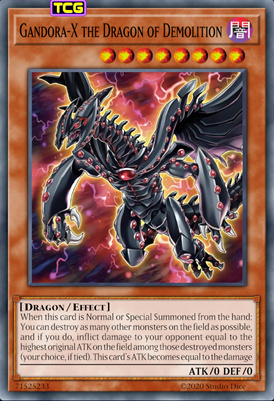
“When this card is Normal or Special Summoned from the hand: You can destroy as many other monsters on the field as possible, and if you do, inflict damage to your opponent equal to the highest original ATK on the field among those destroyed monsters (your choice, if tied). This card’s ATK becomes equal to the damage inflicted to your opponent by this effect. Once per turn, during your End Phase: Halve your LP.”
Note here that in the TCG, it says “highest original ATK”. In the OCG, where this card originated from however, the card text instead states, “highest ATK”. Rather, if we translate the OCG card text, it would read like this:
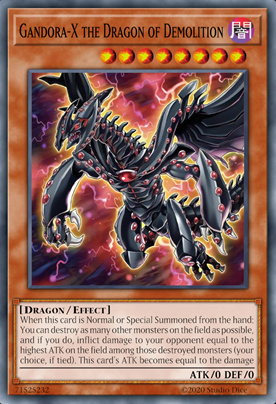
“When this card is Normal or Special Summoned from the hand: You can destroy as many other monsters on the field as possible, and if you do, inflict damage to your opponent equal to the highest ATK on the field among those destroyed monsters (your choice, if tied). This card’s ATK becomes equal to the damage inflicted to your opponent by this effect. Once per turn, during your End Phase: Halve your LP.”
The reason why there is a difference in printed card text between TCG and OCG is unknown. It could be due to a unintentional mistranslation or even an intentional alteration (errata).
Unlike complicated rulings and mechanics that are ambiguous, this is a literal difference on the card text between the TCG and OCG on the card. Thus, here is written evidence of a difference. Hence, based on what region your event is, the effect of the same card could be different. There are not many of these cards, but if you use the wrong printed effect at a sanctioned event, it would be considered illegal.
That’s it! To summarize, there’s two confirmed differences between the TCG and OCG. One is the SEGOC where the OCG uses non-public cards as a lower priority level compared to publicly revealed cards. Second, we have printed card text differences of the same card. That’s it. All other claimed differences have not been documented by any official source. YGO Omega is the first automatic simulator to have these differences programmed into the game successfully. For the first time in history, it has both TCG and OCG rulings.
The future is unknown but as more iteration of master rules emerge, the pattern shows more unity between the TCG and OCG. Maybe OCG will reprint their rulebook to include the ruling on non-public priority which may cause TCG to also translate and reprint their rulebook. That could lead to unity to SEGOC rulings once and for all.
Sources
- https://www.weibo.com/u/7406309913?refer_flag=1005055013_&is_hot=1
- Rulings at the World Championship | Duelist Codex
- https://www.yugioh-card.com/en/gameplay/fasteffects_timing.html
- https://img.yugioh-card.com/en/rulebook/SD_RuleBook_EN_10.pdf (Pages 48-50)
- The Organization | Introducing The Perfect Rulebook
- The Organization | The Perfect Rulebook 2017 (Page 33)
- https://www.db.yugioh-card.com/yugiohdb/faq_search.action?ope=5&fid=13782&request_locale=ja
- The Organization | [OCG] 09/25/2014 OCG rulings
- The Organization | Advanced Rulings: Location Matters
- ルール改訂に伴う変更 | おしらせ | 遊戯王OCG デュエルモンスターズ
- The Organization | Master Rule: April 1st 2020 Revision - Revisions
- Yu-Gi-Oh! TCG Strategy Articles » Problem-Solving Card Text, Part 1: Reading the Cards of Tomorrow
